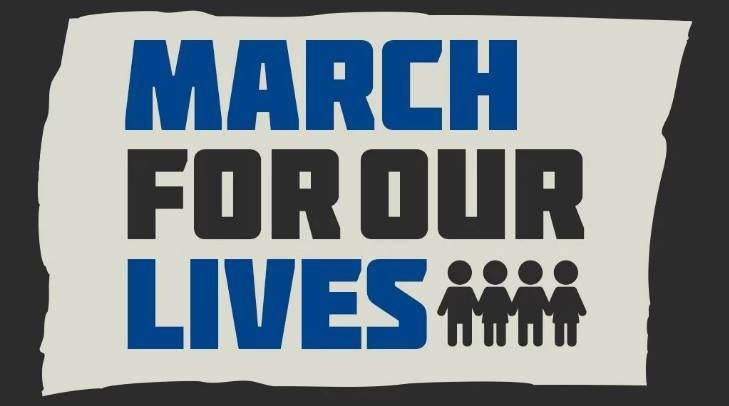This weekend inspired us all. Young people around the country organized the March 24 “March for Our Lives” in response to the February 14 murder of 17 people at Marjory Stoneman Douglas High School in Parkland, Florida. As adults in Congress have largely failed to effectively address the issue of school shootings and gun violence, the people most directly affected by these tragic events are leading us. We should listen.
The need for gun control was the main topic raised from the podium – but the many and diverse students who spoke addressed issues beyond school shootings, including police violence against African Americans and other people of color; ongoing racial inequality in our society (including disparate impacts of gun violence); and differences in media treatment of affluent and white schools versus those in poorer communities and communities of color.
In response to the March for Our Lives, the National Rifle Association offered the same, tired, conspiracy theories:
“Stand and Fight for our Kids’ Safety by Joining NRA…Today’s protests aren’t spontaneous. Gun-hating billionaires and Hollywood elites are manipulating and exploiting children as part of their plan to DESTROY the Second Amendment and strip us of our right to defend ourselves and our loved ones.”
They obviously had not listened to the many sincere and eloquent speakers at the March for Our Lives.
But the NRA’s reversion to far right conspiracy theories is nothing new. For many years the NRA and other gun rights groups have had a firm foot in the politics of organized racism. From the mid-1990s when far right militias rose from the seeds of white supremacy, to the growth of the Tea Party since 2010, guns issues have helped transformed the gun lobby into a “leading edge of a far right, multi-issue assault on government institutions and democratic rights,” IREHR’s Leonard Zeskind wrote in 1995.
The song remains the same. These past articles from IREHR shed light on how “gun rights” have remained a persistent element of racist organizing in the United States.
Armed and Dangerous: The Militia Movement, Larry Pratt and the National Rifle Association
In this 1995 article originally published in Rolling Stone, IREHR’s Leonard Zeskind takes us inside a 1992 white supremacist meeting in Estes Park, Colorado, and a 1995 NRA convention in Phoenix, Arizona, examining how so-called citizens militias rooted in organized racism found a place in the National Rifle Association. Zeskind argues that this period saw the “transformation of the gun lobby” – organizations like Gun Owners of America and “even the National Rifle Association, which were devoted to the single issue of firearms, would become the leading edge of a far right, multi-issue assault on government institutions and democratic rights.”
The NRA and the Hard Right
Jumping ahead almost 20 years, IREHR’s Devin Burghart and Leonard Zeskind examine the National Rifle Association and gun lobby in the context of the growth of the Tea Party movement. The NRA’s 2013 national convention featured a “man size target resembling President Barack Obama” that “allowed attendees to shoot at the president and make him bleed.” The NRA also elected James W. Porter II as its president – a man who “calls Barack Obama a ‘fake president,’ and describes the American Civil War as the ‘War of Northern Aggression,’ a term usually signifying one’s identification with the Confederate South.” As Burghart and Zeskind summarize, “National Rifle Association spokespersons will tell you that the NRA is a non-partisan lobby for the Second Amendment to the Constitution. In real life, it is an organization that bridges conservative Republicans to the hard right.”
“Day of Resistance” Gun Rallies and the Tea Party
In this article, IREHR’s Devin Burghart looks at “Day of Resistance” pro-gun rallies that took place in at some 118 locations in 38 states on February 23, 2013. Driven by Tea Party activists, the rallies saw participation by the far right paramilitary group Oath Keepers and a smattering of white nationalists from the American Freedom Party. The event demonstrated the place of racism in the ideology of this movement, with speakers articulating a need to arm to fend off “roving hordes of heavily-armed (implicitly black) ‘gangbangers’ and (implicitly Latino) ‘drug cartels.’ These are both ‘law and order’ arguments similar to the one used in the 1960s for whites to own guns.”
Hitler and Gun Control
It has long been popular in some gun rights circles to claim that the lead-up to the Holocaust saw Hitler enact gun control and seize guns from German citizens. This was repeated in February by U.S. Representative Don Young (R-AK). Variations on a theme depicting gun regulations as a slippery slope to Nazi-style tyranny have been repeated by groups ranging from the National Rifle Association to Gun Owners of America to the Ludwig von Mises Institute. In this 2009 article IREHR’s Leonard Zeskind reminds us that “The Nazi regime’s restrictions were on citizenship and political reliability, not on guns per se. Hitler did not seize all the guns in 1934 or any other year.”




